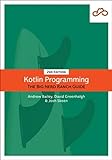To convert XML to a HashMap in Kotlin and ignore empty tags, you can use a library like SimpleXML or JAXB to parse the XML file. Once the XML data is parsed, you can iterate through the parsed data structure and build a HashMap by mapping each XML tag to its corresponding value.
To ignore empty tags, you can check if a tag has a non-empty value before adding it to the HashMap. This can be done by checking the length or presence of a value in the tag, and only adding it to the HashMap if it meets the desired criteria.
Overall, the process involves parsing the XML data, iterating through the parsed data structure, and building a HashMap with the desired key-value pairs while ensuring that empty tags are ignored.
What Kotlin libraries can help with converting XML to a HashMap?
- Simple-XML: A simple library for converting XML to Java objects, which can then easily be converted to a HashMap.
- Jsoup: Not specifically for XML conversion, but Jsoup can be used to parse XML documents and extract data to populate a HashMap.
- JDOM: A popular XML library for Java, JDOM can be used to parse XML documents and extract data to populate a HashMap.
- DOM4J: Another XML library for Java, DOM4J can also be used for parsing XML documents and converting them to a HashMap.
- XmlPullParser: This library can be used to efficiently parse XML documents and convert them to a HashMap in Kotlin.
How to implement a parser to convert XML to a HashMap in Kotlin?
To convert XML to a HashMap in Kotlin, you can use a library like kotlin-xmlbuilder to parse the XML data and then convert it into a HashMap. Here's a step-by-step guide on how to implement a parser to convert XML to a HashMap in Kotlin:
- Add the kotlin-xmlbuilder dependency to your build.gradle file:
1 2 3 |
dependencies { implementation 'org.kotlin:xml-builder:3.2.1' } |
- Create a function that parses the XML data and converts it into a HashMap:
1 2 3 4 5 6 7 8 9 10 11 12 13 14 15 16 17 18 19 20 21 22 23 24 25 26 27 28 29 30 31 32 33 34 35 36 37 |
import org.w3c.dom.Element import org.xml.sax.InputSource import java.io.StringReader import java.util.HashMap import javax.xml.parsers.DocumentBuilderFactory fun xmlToHashMap(xmlString: String): HashMap<String, String> { val documentBuilderFactory = DocumentBuilderFactory.newInstance() val documentBuilder = documentBuilderFactory.newDocumentBuilder() val document = documentBuilder.parse(InputSource(StringReader(xmlString))) val rootNode = document.documentElement val hashMap = HashMap<String, String>() parseNode(rootNode, hashMap) return hashMap } fun parseNode(node: Element, hashMap: HashMap<String, String>) { if (node.hasAttributes()) { val attributes = node.attributes for (i in 0 until attributes.length) { hashMap[attributes.item(i).nodeName] = attributes.item(i).nodeValue } } if (node.hasChildNodes()) { val childNodes = node.childNodes for (i in 0 until childNodes.length) { val childNode = childNodes.item(i) if (childNode is Element) { parseNode(childNode, hashMap) } } } } |
- Use the xmlToHashMap function to convert an XML string into a HashMap:
1 2 3 4 5 6 7 8 9 10 11 |
val xmlString = """ <data> <name>John Doe</name> <age>30</age> </data> """ val hashMap = xmlToHashMap(xmlString) hashMap.forEach { (key, value) -> println("$key: $value") } |
This code will parse the XML data provided and convert it into a HashMap where the keys are the XML tag names and the values are the text content of the tags. You can further customize the parsing logic based on your XML structure and requirements.
What is the process of converting nested XML elements to a HashMap in Kotlin?
To convert nested XML elements to a HashMap in Kotlin, you can use the following process:
- First, parse the XML data using an XML parser library such as kotlin-xml-writer or kotlin-xml-builder.
- Traverse the parsed XML data and extract the nested elements into a HashMap. For each nested element, you can create a key-value pair in the HashMap where the key is the element name and the value is the element value or another nested HashMap if the element has child elements.
- Recursively repeat step 2 for each nested element to build the complete hierarchical structure in the HashMap.
- Once you have extracted all the nested elements into the HashMap, you can access and manipulate the data easily using the keys as references to the elements.
Here is a simple example code snippet that demonstrates the process of converting nested XML elements to a HashMap in Kotlin:
1 2 3 4 5 6 7 8 9 10 11 12 13 14 15 16 17 18 19 20 21 22 23 24 25 26 27 28 29 |
import org.w3c.dom.Element import javax.xml.parsers.DocumentBuilderFactory fun main() { val xmlData = "<root><parent><child1>value1</child1><child2>value2</child2></parent></root>" val document = DocumentBuilderFactory.newInstance().newDocumentBuilder().parse(xmlData.byteInputStream()) val element = document.documentElement val hashMap = hashMapOf<String, Any>() parseXmlToHashMap(element, hashMap) println(hashMap) } fun parseXmlToHashMap(element: Element, map: MutableMap<String, Any>) { for (i in 0 until element.childNodes.length) { val child = element.childNodes.item(i) if (child is Element) { if (child.childNodes.length == 1 && child.childNodes.item(0) is org.w3c.dom.Text) { map[child.nodeName] = child.childNodes.item(0).nodeValue } else { val nestedMap = hashMapOf<String, Any>() parseXmlToHashMap(child, nestedMap) map[child.nodeName] = nestedMap } } } } |
This code snippet parses the given XML data string, extracts the nested elements, and adds them to a HashMap according to the hierarchical structure of the XML. You can customize the parsing logic and data structure as needed based on the specific XML format you are working with.
What is the best way to handle empty tags when converting XML to a HashMap in Kotlin?
When converting XML to a HashMap in Kotlin, it is important to handle empty tags properly to prevent any potential issues. One approach to handling empty tags is to check if a tag is empty before inserting it into the HashMap. If a tag is empty, you can choose to either skip it or insert a default value in the HashMap.
Here is an example of how you can handle empty tags when converting XML to a HashMap in Kotlin:
1 2 3 4 5 6 7 8 9 10 11 12 13 14 15 16 17 18 19 20 21 22 23 24 25 26 27 |
import org.w3c.dom.Element import org.w3c.dom.Node import javax.xml.parsers.DocumentBuilderFactory fun xmlToHashMap(xmlString: String): HashMap<String, String> { val document = DocumentBuilderFactory.newInstance().newDocumentBuilder().parse(xmlString.byteInputStream()) return hashMapOf<String, String>().apply { traverseXml(document.documentElement, this) } } private fun traverseXml(node: Node, hashMap: MutableMap<String, String>) { if (node is Element) { if (node.childNodes.length == 1 && node.textContent.isBlank()) { // Handle empty tag hashMap[node.nodeName] = "default_value" } else { hashMap[node.nodeName] = node.textContent } val childNodes = node.childNodes for (i in 0 until childNodes.length) { traverseXml(childNodes.item(i), hashMap) } } } |
In the above code snippet, we define a function xmlToHashMap that takes an XML string as input and converts it into a HashMap object. We then traverse the XML document and handle empty tags by checking if a tag is empty (i.e., has no text content) before inserting it into the HashMap. If a tag is empty, we insert a default value instead.
This approach allows for handling empty tags in a customizable manner and ensures that the conversion from XML to a HashMap is done accurately.
What is the most efficient way to convert XML to a HashMap in Kotlin?
One efficient way to convert XML to a HashMap in Kotlin is by using a library such as Jsoup. Jsoup is a Java library that allows you to parse HTML and XML documents. You can use Jsoup to parse the XML document and then convert it to a HashMap.
Here is an example of how you can convert XML to a HashMap using Jsoup in Kotlin:
1 2 3 4 5 6 7 8 9 10 11 12 13 14 15 16 17 18 19 20 21 22 23 24 25 26 27 28 29 30 31 |
import org.jsoup.Jsoup import org.jsoup.nodes.Document fun xmlToHashMap(xmlString: String): HashMap<String, Any> { val doc: Document = Jsoup.parse(xmlString, "", org.jsoup.parser.Parser.xmlParser()) val result: HashMap<String, Any> = HashMap() fun parseNode(node: org.jsoup.nodes.Node) { val keys = node.attributes().asList().map { it.key } val values = node.attributes().asList().map { it.value } keys.zip(values).forEach { entry -> result[entry.first] = entry.second } node.childNodes().forEach { childNode -> parseNode(childNode) } } parseNode(doc) return result } fun main() { val xmlString = "<xml><name>John Doe</name><age>30</age></xml>" val hashMap = xmlToHashMap(xmlString) println(hashMap) } |
In this example, the xmlToHashMap function takes an XML string as input, uses Jsoup to parse the XML document, and then recursively iterates through each node to extract the attributes and values and store them in a HashMap. You can then use the resulting HashMap however you need in your Kotlin code.









